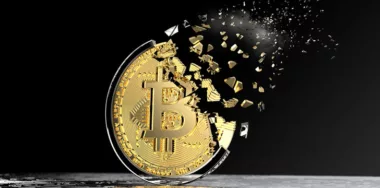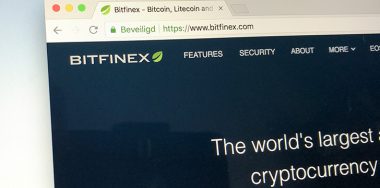| Getting your Trinity Audio player ready... |
Tether’s (NASDAQ: USDT) latest reserves attestation shows a curious lack of cash on hand, while Binance’s founder is going all-in on stablecoins not named Tether.
On Monday, the rented mailbox that publicly represents the Tether (USDT) stablecoin released its latest ‘independent auditors’ report behind the consolidated reserves report.’ For those who don’t speak wilting word salad, that means someone at BDO Italia read a barebones list of figures submitted by the Tether crew, shrugged and said ‘sure, why not.’
According to this report, as of June 30, Tether had assets worth $86.5 billion, supporting the then-total of $83.2 billion in circulating USDT (a new record that has since grown to nearly $83.8 billion).
These alleged reserves were $7.1 billion higher than the sum reported at the end of Q1 and included an alleged $3.3 billion ‘profit’ that Tether has generated by selling a token allegedly worth one U.S. dollar for (checks notes) one U.S. dollar. That profit is more than double the $1.5 billion Tether reported in the last report.
Tether claims its alleged stash of U.S. Treasury Bills has now topped $55.8 billion, $2.8 billion higher than three months prior. However, Tether further claims that its actual T-bill exposure is over $72.5 billion when you include ‘indirect’ investments via overnight reverse repurchase agreements and money market funds.
That would place Tether ahead of many sovereign states, including the United Arab Emirates and Mexico, which respectively hold $70.2 billion and $68.4 billion in T-bills. According to Tether sources, its trough of T-bills is at least partially overseen by Cantor Fitzgerald, although the Wall Street investment bankers have never publicly confirmed this claim.
Meanwhile, Tether still has $5.5 billion in ‘secured loans’ on its books, about $150 million more than in Q1, despite Tether’s promises to purge these ‘assets’ from its books. Tether also cites over $2.35 billion in ‘other investments,’ which are generally understood to be illiquid meme coins that no one but Tether would consider a safe harbor.
Cash crunch
While Tether claims its T-bills have a “residual average maturity of less than 90 days” and its reverse repo agreements have a maturity of a single day, Tether’s actual available cash supplies have been reduced to almost nothing.
At the end of 2022, Tether said it had $5.3 billion of real cash on hand, but this sank to $481 million at the end of Q1 2023 and sank further to less than $91 million at the end of Q2. Assuming that the burn rate continued through July, Tether probably keeps its current cash stash in coin rollers in a junk drawer.
It’s not hard to theorize on what contributed to this cash-averse pivot, including the loss of access to U.S. banking institutions earlier this year. Reputable banks appear utterly disinterested in associating themselves with Tether’s tarnished brand, particularly following reports that Tether and its affiliated Bitfinex digital asset exchange previously engaged in bank fraud to keep the cash flowing.
More recently, U.S. authorities seized $45 million held in U.S. accounts on behalf of Tether’s Bahamian banking partner Deltec Bank & Trust, which the Department of Justice (DOJ) alleged had “misrepresented the purpose and use” the accounts.
Sharing the wealth
There may be another reason Tether’s cash pile is dwindling. In the press release touting the Q2 report, Tether stressed that its surplus reserves “are the company’s own profits—not distributed to shareholders.” Nonetheless, Tether simultaneously announced a $115 million “share buyback” intended to “further strengthen the shareholder group.”
Conveniently, Forbes ran a piece over the weekend detailing how much Tether’s four public faces—CEO Jan Ludovicus van der Velde, CFO Giancarlo Devasini, CTO Paolo Ardoino, and general counsel Stuart Hoegner—would be worth if Tether was sold. Based on Forbes’ estimates of Tether’s price tag, these four are all on-paper billionaires.
Devasini reportedly holds the largest stake (40%) in Tether, which would mean a $4 billion payday should Tether change hands. Van der Velde and Ardoino could be looking at $1.8 billion apiece, while Hoegner brings up the rear with $1.2 billion. It’s unclear what shares might be held by other staff, mainly because the above four are the only individuals who admit working for Tether.
Of course, with Daniel Friedberg—Hoegner’s former (and literal) partner-in-crime—currently awaiting the filing of criminal charges for his role in the FTX fraud, perhaps it’s best not to count one’s chickens before they hatch. Particularly if Friedberg decides to spill what he knows about the nearly $40 billion that FTX’s affiliated market-maker Alameda Research sent to Tether before the walls came tumbling down—including how much of that was FTX customer cash.
All of which makes you wonder: is Tether’s ‘share buyback’ really intended to ‘strengthen’ its shareholders, or are the principals simply cashing out before any more funds are seized?
Better Do Over
A brief word of advice for BDO Italia, the seventh or eighth firm Tether has enlisted to provide its ‘attestations,’ which are most definitely not the equivalent of an independent audit. Despite repeated promises that an actual audit was in the works, Tether has never submitted its reserves to legally-binding scrutiny.
A few days before Tether’s latest report, the U.S. Securities and Exchange Commission (SEC) issued a public warning to accounting firms hired by ‘crypto’ operators “to perform some sort of review of certain parts of their business, often presented as a purported ‘audit.’”
The SEC warned bean counters to “keep several obligations and hazards front of mind,” including the fact that any material misstatements regarding what these reports actually represent “could result in legal liability for the accounting firm.”
Et tu, CZ?
Binance founder Changpeng ‘CZ’ Zhao has previously referred to Tether as “a black box,” expressing doubts over the veracity of Tether’s reserves and suggesting that he doesn’t always “feel comfortable” regarding his ability to redeem USDT at its stated 1:1 ratio with the U.S. dollar.
On Monday, CZ participated in a Twitter—sorry, ‘X’—Ask Me Anything (AMA) session, during which he recycled his ‘black box’ quote, adding that “I have not personally seen any audits” from the Tether camp. “Most people I’ve spoke to have not seen either.”
Given the billions of USDT that have flowed onto the Binance exchange over the years, CZ’s public dissing of the grease that keeps his crooked gears turning is more than a little intriguing.
The first time CZ dissed Tether was in October 2022, a month after Binance began forcibly converting customers’ USDC stablecoins to BUSD. The latter was a co-venture of Binance and New York-based Paxos Trust, and Binance heavily promoted its use by eliminating trading fees on BUSD pairs. CZ evidently wanted BUSD to play a more dominant role in stablecoin-based activity on his exchange.
But that plan came undone in February when the New York Department of Financial Services (NYDFS) ordered Paxos to distance itself from Binance. The NYDFS took issue with the fact that Binance was issuing its own version of BUSD without sufficient reserve assets, effectively allowing Binance to print money out of thin air without informing customers of this magic power.
Undaunted, Binance transferred its zero-fee affections to TUSD, the Justin Sun-linked stablecoin of equally sketchy backing, and the wash trading that has long inflated the price of tokens like BTC continued uninterrupted.
CZ recently threw his zero-fee support behind another new stablecoin, FDUSD, which also appears to be ‘Justin Sun-adjacent.’ CZ used that occasion to cast more shade on stablecoin incumbents, suggesting that they “are not always stable” and that tokens such as BTC were “more stable than stablecoins now.”
During Monday’s AMA, CZ claimed his ‘more stable than stablecoins’ comment was a joking reference to BTC’s fiat value having been confined to a (suspiciously) narrow range for a long time. But he also offered insights into Binance’s new stablecoin strategies.
CZ said Binance is taking a ‘decentralized’ approach to stablecoins, saying, “we shouldn’t have a single bet. We should work with as many stablecoins as possible.” CZ added that Binance was looking to launch more Euro-based stablecoins, despite the number of European markets in which Binance operates growing smaller by the day.
CZ also said Binance was working on another stablecoin partnership, the details of which he declined to disclose. And incredibly, despite last year’s ‘crypto’ contagion being sparked by the failure of Terraform Labs’ wonky ‘algorithmic stablecoin’ UST, CZ said Binance has “a small team working on algo stablecoins in different places that are not high-scale but are very relevant locally.”
CZ claimed UST was “poorly designed, poorly executed, and poorly maintained,” issues he will undoubtedly try to ensure aren’t present in whatever algorithmic monster eventually emerges from Binance’s back offices. It wouldn’t surprise us if he finds a role to play for Binance’s struggling in-house BNB token, the price of which CZ has been vigorously defending this year.
Survivor: Crypto—the tribe has spoken
Stablecoins have taken on far greater significance of late due to Binance’s inability to maintain banking relationships, leading to a paucity of fiat on-/off-ramps. CZ said Monday that banks were increasingly “reluctant to work with crypto or Binance” due to the constant stream of “negative news,” including the growing number of lawsuits the company is facing.
The friction between CZ and Tether could also reflect the public betting on which one will be first to face U.S. criminal charges. Binance is the current odds-on favorite, although a Wednesday Semafor report suggested the DoJ was delaying its filing over concerns that an indictment could spark a ‘run on the bank.’
The apparent implication is that Binance wouldn’t be able to handle a run due to the disconnect between its assets and liabilities. (This is why Binance and Tether fight: these crazy kids are just too much alike.)
No doubt CZ and Tether’s Ardoino are currently exchanging text messages on this very subject as we speak. With any luck, they’re finding common ground in the idea of mutually throwing Justin Sun under the bus in the hope of (a) buying some time, and (b) possibly getting a better deal from the feds on their own charges.
Remember, you don’t have to be faster than the bear; you just have to be faster than your friends.
Follow CoinGeek’s Crypto Crime Cartel series, which delves into the stream of group—from BitMEX to Binance, Bitcoin.com, Blockstream, ShapeShift, Coinbase, Ripple,
Ethereum, FTX and Tether—who have co-opted the digital asset revolution and turned the industry into a minefield for naïve (and even experienced) players in the market.
New to blockchain? Check out CoinGeek’s Blockchain for Beginners section, the ultimate resource guide to learn more about blockchain technology.








